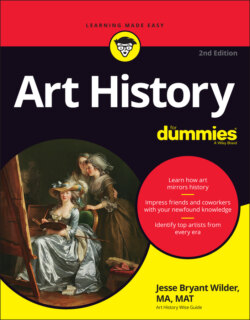Читать книгу Art History For Dummies - Jesse Bryant Wilder - Страница 129
Creating balance and proportion
ОглавлениеThe artist Polykleitos created a feeling of balance with contrasting tensions that also suggest motion. The off-center pose that gives this relaxed but balanced look is called contrapposto. The Greek philosopher Heraclitus (circa 535 BC–475 BC) summed up the concept: “Opposition brings concord.”
You can see the contrapposto effect in a Roman copy of Polykleitos’s Doryphoros (“Spear Bearer”; see Figure 7-6):
The cocked left arm contrasts with the straight or engaged right leg, while the straight right arm offsets the bent left leg.
The left leg seems to propel the figure forward.
Opposite forces preserve the feeling of balance while creating a sense of tension and action.
Almost 2,500 years after he was carved, Doryphoros still has the glow of Greece’s Golden Age (circa 450 BC–440 BC). Polykleitos wrote a book of rules of proportion called the Canon; it was followed by succeeding generations of Greek and Roman sculptors. He cast his original Doryphoros in bronze to demonstrate the principles of the Canon. The many surviving marble copies of Doryphoros attest to its popularity and to the respect that Roman copyists had for the Canon of Polykleitos.
The Greek term canon means “rule” or “standard.” Today, when people speak of the canon of art history, they’re referring to the masterpieces that “measure up” or meet a set of artistic standards, allowing them to be classed with the greatest works of all ages.
Dima Moroz / Shutterstock
FIGURE 7-6: This Roman copy of Polykleitos’s Doryphoros is at ease and tense at the same time.
